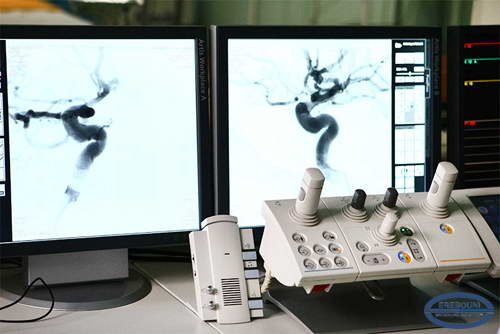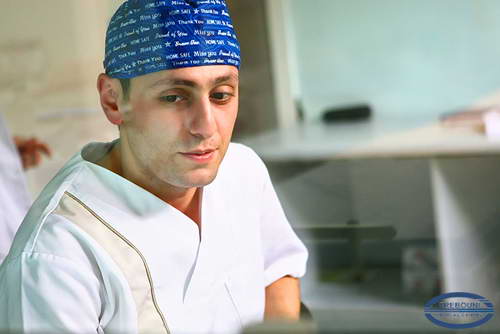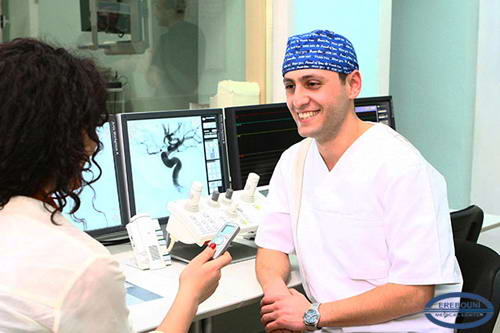Young neurosurgeon David Sahakian recently had performed an exclusive endovascular intervention on the venous system of the brain. The first time in the world such surgery had been performed at the 90s of the last century.
David Sahakyan, who has passed his training in the United States, had note in our discussion that the personnel and technical facilities of the Erebouni medical center are almost equal to that in American clinics.
– What is the exclusivity of endovascular intervention?
– Exclusivity of endovascular intervention is that in difference with the neurosurgical access it creates the opportunity to treat the venous system of the brain without violating the structural integrity of the skull and the brain. We manipulate from inside of the vessels thereby minimize the damage that can be caused by interference.
This circumstance is a great advantage in comparison with neurosurgery. We treat such pathologies of the vascular system as brain vascular aneurysm, arteriovenous malformations, and fistulas. These diseases often lead to a stroke of the brain, creating a serious threat to the life.
In these circumstances it is paramount important that the neutralization of these pathologies was performed as quickly as possible and in minimally invasive manner. Accumulated by many years of international experience shows that the use of these technologies has a positive impact on health outcomes, greatly reducing the likelihood of death and disability.
 – Is it means that the main advantage of endovascular intervention is that it takes place bloodless?
– Is it means that the main advantage of endovascular intervention is that it takes place bloodless?
– I would say almost bloodless. Using special tools and techniques, we are reaching the arteries that feed the brain through the femoral artery access. Sometimes we have to deal also with the venous system. Such technique is used by cardiologists for performance of coronary artery stenting. Our interventions have a certain similarity with it but we just have to deal with the vessels of the brain.
– It turns out that, thanks to this method it will be possible to treat stroke?
– There are two types of cerebral insults. The first is when bleeding occurs from the vascular system in the brain tissue, or under the meninges. In this case, it is important to identify vascular abnormalities that give rise to hemorrhage. Once identified, they need to be neutralized to prevent re-bleeding. In most cases, the best way to neutralize these anomalies is the endovascular method.
The second type is the thrombosis of arteries supplying the brain, which leads to the death of brain tissue. In this case, under certain circumstances, the only way to save may be a removal or dissolution of vascular thrombus.
In case of accidental detection of vascular lesions of the brain, endovascular surgery plays a very important and crucial role in the prevention of deaths from stroke.
 – Tell us, please, about the recently performed exclusive case of endovascular intervention.
– Tell us, please, about the recently performed exclusive case of endovascular intervention.
– It was the first time performed at Erebouni MC such kind of intervention. The patient was 36-year-old man who complained of headaches and a feeling of heat in the head. After complete set of diagnostic examination procedures it was stated the diagnosis of subarachnoid hemorrhage. Typically, the main cause of hemorrhage is a brain vascular aneurysm that represented in form of bag-shaped protrusion of the wall of the vessel.
An aneurysm may be asymptomatic, but suddenly in one day lead to a rupture of the vessel's wall and hemorrhage in the brain with the development of life-threatening complications. The first common symptoms of this disease are dire unbearably severe headache, nausea, unconsciousness, and spasms of the neck muscles. 15% of patients with the condition die before admission to the hospital, 67% dies without having surgery, and in the case of surgical treatment the mortality reduces by twice and significantly increases a favorable outcome of disease.
The purpose of endovascular intervention is to neutralize the aneurysm, which at any moment may rupture. From the inside of the vessels the microcoils are inserted into the aneurysm. Later on, around these coils the scar tissue is formed and the integrity of the vessel is fully restored. Depending on the type and size of the aneurysm the endovascular intervention may typically lasts a maximum of three hours.
– Is the success of this endovascular intervention mostly dependent on the skill of the doctor or the technical facilities?
– In modern neurosurgery are equal important as skills of physician as technical facilities. To date, the catheterisation laboratory of Erebouni MC is equipped with the latest generation of angiography system of Siemens, which has no analogues in Armenia. In addition, the staff that works at Erebouni MC has passed training and specialization at well known hospitals in USA and EU.
– How is the patient at the post-operative period?
– Even after the neutralization of the aneurysm is still possibility to re-bleeding. For this reason, treatment should be carried out in an intensive care unit, where is he now.
– In which age group of population is mainly occurs the arterial aneurysm of the brain?
– It mostly found in the population of middle-aged and older. Only 2% of population can have aneurysms as congenital disease. The main factors contributing to the emergence of a brain aneurysm are uncontrolled blood pressure, smoking and genetic predisposition.

